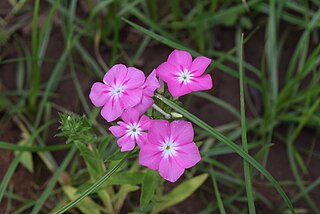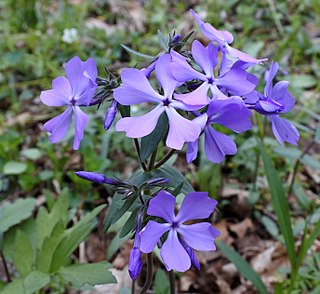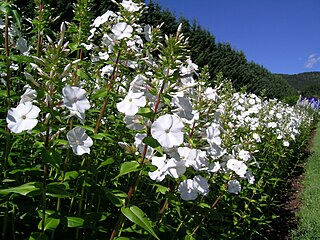
Phlox is a genus of 68 species of perennial and annual plants in the family Polemoniaceae. They are found mostly in North America in diverse habitats from alpine tundra to open woodland and prairie. Some flower in spring, others in summer and fall. Flowers may be pale blue, violet, pink, bright red, or white. Many are fragrant.
"Doctor's Orders" is the sixteenth episode from the third season of the science fiction television series Star Trek: Enterprise. It's the sixty-eighth episode of the series, first airing on February 18, 2004.

Phlox is a fictional character, played by John Billingsley, in the television series Star Trek: Enterprise. Set in the 22nd century in the science fiction Star Trek universe, he is the chief medical officer aboard the first Warp 5 starship, Enterprise (NX-01), commanded by Captain Jonathan Archer. Phlox first appears in the premiere episode, "Broken Bow" (2001), marking the franchise's introduction of the Denobulan race.

The Polemoniaceae are a family of flowering plants consisting of about 25 genera with 270–400 species of annuals and perennials native to the Northern Hemisphere and South America, with the center of diversity in western North America.

Phlox stansburyi is a species of phlox known by the common names cold-desert phlox and pink phlox. It is native to the southwestern United States from California to Utah to Texas, where it occurs in desert and plateau scrub and woodland habitat.

Phlox drummondii is a flowering plant in the genus Phlox of the family Polemoniaceae. Native to Texas, it is also widely distributed in the southeastern United States, especially along public highways. P. drummondii is often used as an ornamental plant. The flowers have a wide range of colours "from white and cream through pinks, lilacs, roses, purples and reds, to almost black".

Phlox subulata the creeping phlox, moss phlox, moss pink or mountain phlox, is a species of flowering plant in the family Polemoniaceae, native to eastern and central USA, and widely cultivated.

Phlox divaricata, the wild blue phlox, woodland phlox, or wild sweet william, is a species of flowering plant in the family Polemoniaceae, native to forests and fields in eastern North America.

Phlox pilosa, the downy phlox or prairie phlox, is an herbaceous plant in the family Polemoniaceae. It is native to eastern North America, where it is found in open areas such as prairies and woodlands.

Phlox paniculata is a species of flowering plant in the phlox family (Polemoniaceae). It is native to parts of the eastern and central United States. It is extensively cultivated in temperate regions as an ornamental plant and has become established in the wild in scattered locales in other regions. Common names include fall phlox, garden phlox, perennial phlox, summer phlox, and panicled phlox.

Phlox nivalis is a species of flowering plant in the Polemoniaceae family, it is commonly known as the trailing phlox, but other common names include Pineland phlox, Pine phlox, and sweet trailing. It is native to the southeastern states, along with Texas, Utah, and Michigan.
The North America Prairies is a large grassland floristic province within the North American Atlantic Region, a floristic region within the Holarctic Kingdom. It lies between the Appalachian Province and the Rocky Mountains and includes the prairies of the Great Plains. It is bounded by the Canadian coniferous forests on the north and the arid semideserts to the southwest. The province itself is occupied by temperate grasslands, savannas, and shrublands. Endemism is rather limited in this province, and its boundaries are vague. During the Pleistocene much of the province was glaciated.

Phlox is an unincorporated community in the town of Norwood, Langlade County, Wisconsin, United States. It is situated on Wisconsin Highway 47 southeast of Antigo. Phlox has a post office with ZIP code 54464. In the Menominee language it is called Omāhkahkow-Menīkān which means "frog town". It lies within ancestral Menominee territory which was ceded to the United States in the 1836 Treaty of the Cedars.

Phlox diffusa is a species of phlox known by the common name spreading phlox. It is native to western North America from British Columbia to the southwestern United States to the Dakotas, where it grows in many types of habitat, including rocky, high elevation mountain slopes. It is a very compact mat-forming perennial herb growing in cushions or patches of short, decumbent stems. The linear, lance-shaped, or needle-like leaves are no more than 1.5 centimeters long and are oppositely arranged in bundles on the short stems. The inflorescence is a solitary tubular flower around a centimeter long. It has a flat white or pale pink or blue corolla with five lobes each just under a centimeter in length.

Phlox carolina, the thickleaf phlox, is a species of flowering plant in the family Polemoniaceae. It is an herbaceous perennial growing to 1.2 m (4 ft) tall by 45 cm (18 carolina refers to its native habitat in the eastern United States. It grows in woodland edges and openings. Flowers attract bees, hummingbirds, and butterflies.

Village Creek is a blackwater tributary of the Neches River in Texas, United States. It arises in northwestern Hardin County outside the community of Village Mills. Due to the waterway's isolation and absence of impoundments, it is known to be pristine supporting cypress swamps and hardwood forests, as well as many rare and endangered species. It is 63 miles (101 km) long and average streamflow at the mouth is approximately 1,000 cubic feet per second (28 m3/s). It passes through three conservation areas on the way south, being: the Big Thicket National Preserve - Village Creek Corridor Unit, Roy E. Larsen Sandyland Sanctuary, and Village Creek State Park.
Phlox oklahomensis, the Oklahoma phlox, is a species of flowering plant in the family Polemoniaceae. It can be found in the prairies of Kansas, Oklahoma and Texas.

Phlox maculata, common names wild sweetwilliam and meadow phlox, is a species of flowering plant in the family Polemoniaceae, native the eastern United States and introduced to eastern Canada. It is a perennial.
Phlox roemeriana, the goldeneye phlox, is a species of flowering plant in the family Polemoniaceae, native to Texas. There it is found only on dry limestone soils of the Edwards Plateau and nearby areas of the High Plains. An annual reaching 13 cm (5 in), it has pink flowers with a yellow center.
Phlox cuspidata, the pointed phlox, is a species of flowering plant in the family Polemoniaceae, native to the US states of Oklahoma, Texas, and Louisiana. An annual reaching 25 cm (10 in), its hybridization dynamics with and partial reproductive isolation from Phlox drummondii are the subject of scientific inquiry.














